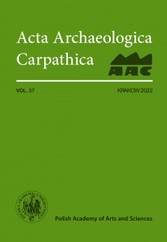Results of excavation at the Roman Period site in Podegrodzie, Nowy Sącz district
Results of excavation at the Roman Period site in Podegrodzie, Nowy Sącz district
Author(s): Renata Madyda-Legutko, Krzysztof TuniaContributor(s): Anna Skucińska (Translator)
Subject(s): Archaeology, Cultural history, Regional Geography, Historical Geography, Local History / Microhistory, Ancient World
Published by: Wydawnictwo Uniwersytetu Jagiellońskiego
Keywords: Carpathians; Late Roman Period; Early Migration Period; North Carpathian group; jug; Krausengefäße;
Summary/Abstract: In the Late Roman and the Early Migration Periods, i.e. the 4th and the early 5th centuries AD, in the Polish Western Carpathians, especially in the Sącz Basin, the adjacent Sącz Beskid Mts and Wyspowy Beskid Mts as well as in the Krosno-Jasło Basin, a significant intensification of settlement is observed. The area has been investigated through archaeological surface surveys and excavations; in the Sącz region, five sites have been excavated with the results published to date. This text presents the results of test excavation at yet another site, Podegrodzie 7, Nowy Sącz district. In the feature investigated there a rare jug ornamented with glossed triangles, several storage vessels of the Krausengefäße type, as well as some organic remains were discovered. Palaeobotanical analysis has shown that common barley (Hordeum vulgare) was the predominant species cultivated by the inhabitants of this territory. The radiocarbon date obtained from a charcoal sample corresponds to the chronology of the site determined by the ceramics typology. The results of the excavation at Podegrodzie 7 site are complemented with a map presenting the location of settlement in that area in the Late Roman and the Early Migration Periods.
Journal: Acta Archaeologica Carpathica
- Issue Year: 2022
- Issue No: 57
- Page Range: 89-114
- Page Count: 26
- Language: English

